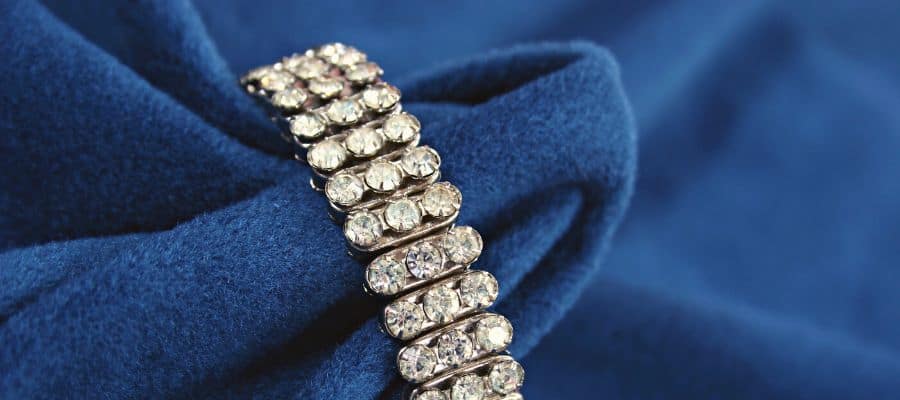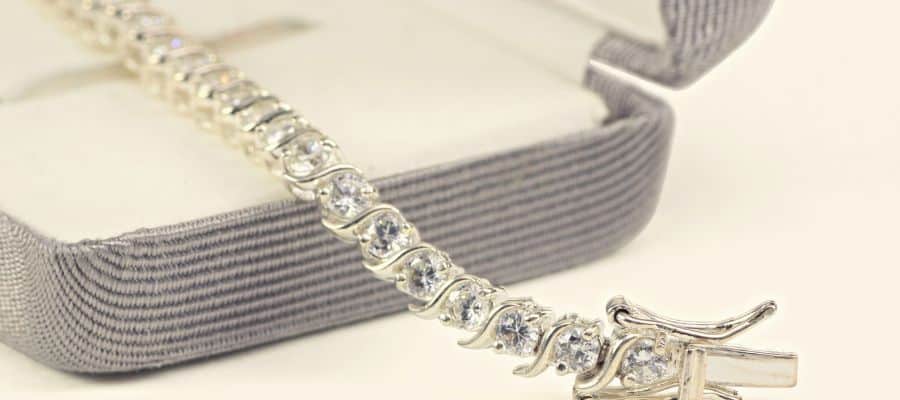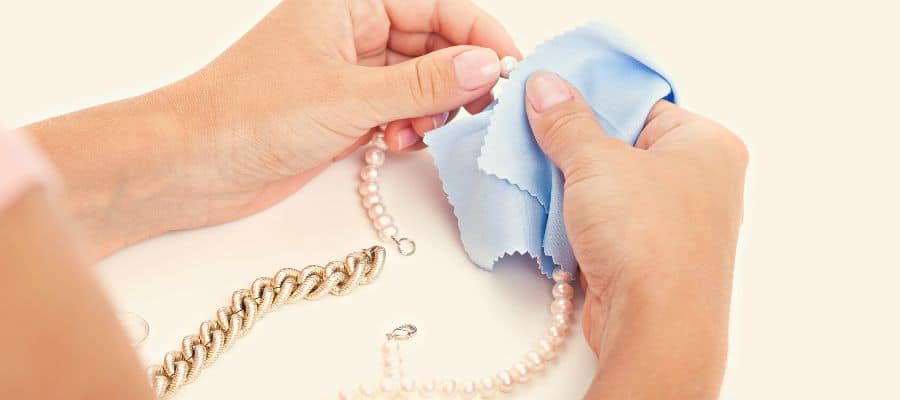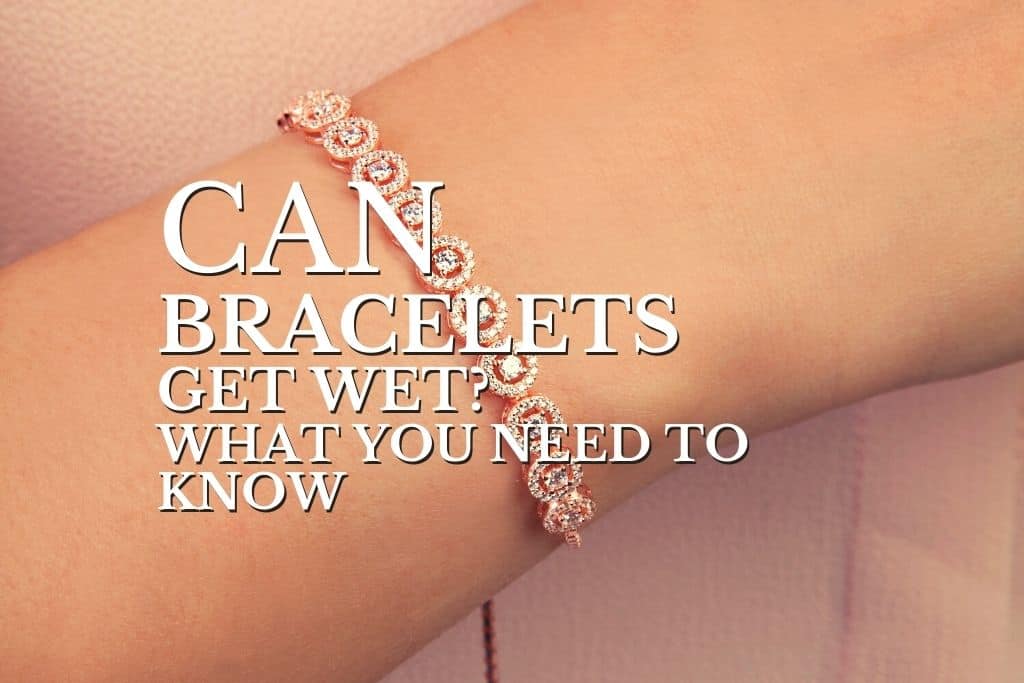A good piece of jewelry can effortlessly elevate an outfit–whether you’re off to a formal dinner or going for a dip at the beach. And who doesn’t want to look fab in a swimsuit, right? But when it comes to getting bracelets wet, there is always that worry that they could get damaged. Is it okay to wear bracelets in the shower or while swimming?
Bracelets that are made of solid gold, gold-filled, or pure sterling silver will not get damaged when exposed to water. However, continuous exposure to moisture can cause these pieces of jewelry to lose their luster, as residue from chemicals in the water can accumulate over time.
So if you’re planning to go for a swim with your bracelets on, make sure that they’re made of materials that won’t tarnish in water and clean them thoroughly when you get home. If you want to understand how water damages bracelets and why, as well as what types are safe for a beach trip, read on.
Does Water Damage Bracelets?

Water itself won’t damage bracelets that are made of certain materials, such as pure gold or pure sterling silver. However, the chemicals and minerals that are often found in water, such as bleach and chlorine, can damage certain types of bracelets, especially with extended exposure.
Also, while water will not necessarily damage your expensive gold-filled or pure gold bracelet, it can affect its luster with prolonged water exposure, causing it to look darker than usual or dull. Depending on the design of the bracelet, those with tiny gaps are also more prone to accumulating debris and residue, making it much more difficult to clean.
On the other hand, less expensive bracelets like fancy or costume jewelry easily tarnish and even rust when exposed to water. While you can safely dip your gold-filled bracelet for a few hours without seeing any negative effects, you will definitely see a tarnish pretty quickly with a brass one.
The best way, therefore, to keep your bracelets looking their best for as long as possible is by limiting water exposure. Take them off before a shower or a dip in the water, and keep them in a place where there is little humidity.
Reasons Why Water Can Damage Jewelry

So why exactly does water damage jewelry? Isn’t water supposed to be the safest liquid ever? Well, when it comes to maintaining jewelry, not exactly. And the reason behind this is not really water itself but what is usually found in water that is the culprit.
So if you’re talking about filtered water for a pure gold bracelet, you should not have any problems. But when you’re taking a shower, going for a dip in the pool, or swimming at the beach, that’s a completely different story.
Let’s find out why it is that water can cause precious bracelets to tarnish and lose their luster.
Chlorine Can Cause Metals To Disintegrate
As we already mentioned, it’s not exactly water itself that does the damage but what’s in the water. And when we talk about water that we use in the shower, or that is in our swimming pools, we know that it’s loaded with either bleach or chlorine as a purifying agent.
The thing about chlorine being mixed with water is that water actually speeds up the corrosion process that this chemical does to metals. This means that pieces of jewelry that are not made of pure gold, silver, or other tarnish-proof metals will actually still show signs of corrosion with extended or habitual water exposure.
What happens with a 9-karat gold-plated bracelet when plunged into chlorine water, for example, is that the thin gold plating will corrode and become brittle or discolored. The gold plating can also get easily scratched, and when it is tarnished, it, unfortunately, stays that way for good unless you get it professionally fixed.
Other abrasive substances that can corrode gold-plated jewelry are the following:
- Bleach
- Fruit acids, like lemon juice
- Vinegar
- Sulfur
If you know that you’re going to come in contact with any of these substances, best remove your bracelets beforehand.
Water Is Unsafe for Loose Setting
Another less talked-about fact about dipping in the water with jewelry like bracelets on is if there are gems or stones that are loosely set, they can easily come off and get lost forever. This happens so often with bracelets because they are practically dangling in our arms, and when you’re swimming, it’s hard to pay attention to whether everything is still intact.
If you’re going to shower or go swimming with your bracelets on, you should, therefore, not only make sure that they are of a tarnish-proof material. You should also make sure that everything is set snugly–especially if we’re talking about the possibility of losing precious stones like diamonds. Oof! Nobody wants that!
Saltwater Can Erode Jewelry
Going back to an earlier point–which is that it’s not the water itself that causes damage but what’s in it–it’s the salt in saltwater that also can ruin our precious bracelets. Like chlorine, saltwater is very abrasive and will easily erode the base metals in jewelry, particularly those that are not made of pure sterling silver or gold.
Any gold bracelet that is less than 14 karat, then, should be taken off before a dip in the sea. If you want to err on the safe side and keep all your jewelry looking lustrous and shiny, we can even go further by saying that you should take off any piece of jewelry before a swim regardless of the purity of the material.
Other Things That Damage Jewelry

There are other things that, like water, are not abrasive but can actually damage bracelets. And if you have not been keen on properly maintaining your jewelry before, you might be surprised to realize that you could have been using these products on a daily basis, all while wearing your precious jewelry.
Here are other everyday things that can actually ruin your jewelry:
Lotions and Creams
Taking care of your skin is always a good idea, but when it comes to applying lotions, creams, and other skincare products, it’s best to do it with your jewelry off. These can leave a residue on your jewelry, causing them to become lackluster over time.
Also, lotions and heavy creams can easily get into the tiny crevices in bracelets, especially around intricate chains and designs. This residue can build up, creating a whitish or even greenish film on jewelry. Thankfully, this residue can be removed, but once a thick build-up has formed, cleaning can be a time-consuming business.
Hand Sanitizers
If your hand sanitizer is made with alcohol, you have nothing to worry about, as long as your bracelet is of high-karat gold or pure silver. But if your sanitizer is alcohol-free, it usually is made with chlorine, which we already know is quite abrasive to jewelry, and causes it to become weak and brittle. Bracelets made of low-purity gold can also become tarnished over time.
So if you would rather use a hand sanitizer instead of alcohol for disinfecting, make sure to check the ingredients list beforehand.
Sweat and Body Oils
Many of us practically live in our jewelry and can’t bear to take them off even when we’re at the gym. If you’re one such person, you should have no problem sweating it out with a gold bracelet on, as long as it is of high purity, such as at least 14-karat gold.
Anything of lower purity will tarnish with continuous exposure to sweat and body oils, making the bracelet look dull and, in other cases, even brown or greenish. If your bracelet is made gold-plated over a copper base, do not forget to take it off because the thin gold plating will eventually corrode.
Also, even if your bracelet is pure gold or gold-filled, it can still look lackluster when you keep wearing it to the gym because your sweat and body oils will leave a film on the bracelet. If you can’t resist wearing your bling to a workout, do not neglect thoroughly cleaning it afterward.
How To Clean Bracelets

If you have recently been on a beach getaway and worn your bracelets while swimming or if you have a habit of wearing bracelets to a workout, the first thing you should do when you get back home is to take off your jewelry and give it a good clean.
Cleaning your bracelets regularly will save you the hassle of having to get them professionally restored to their original luster. Plus, it’s easy and less time-consuming than having to do a one-time-big-time cleaning after several months.
Here’s how to clean a pure gold, gold-filled, gold vermeil, or pure sterling silver bracelet that has been dipped in salt water or soaked in sweat:
- Immediately rinse the bracelet with clean water.
- In a small bowl, put a mixture of warm water and a few drops of dishwashing liquid.
- Soak the bracelet in the gentle cleaning mixture for 15 minutes.
- Take the bracelet out of the bowl and rinse it with clean water.
- Dry the bracelet with a paper towel or cloth.
Even if you think that the residue on your bracelet is too thick, refrain from using any abrasive chemicals like bleach or alcohol. You may use a brush to gently slough away thick reside from tiny crevices but use only a soft-bristle toothbrush. Any other harder-bristle brush can potentially damage the thin gold layer in gold-plated bracelets.
Types of Bracelets That Can Get Wet

Now, let’s talk about the types of bracelets that you can confidently wear in the shower without having to worry about them getting ruined. If you like living in your bling, these are the types of bracelets that you should keep:
Pure Gold
Nothing beats 100 percent pure gold. You can wear this in the shower, at the beach, at the pool, at the gym–everywhere! No amount of water exposure will get through this baby. Still, pure gold bracelets will become dull over time with extended exposure to water and other skin care products.
Still, nothing that a good wipe down or a thorough after-swim clean can fix. You won’t see any tarnish, rust, or discoloration with this one.
Gold-Filled
Another sturdy type of jewelry that can withstand its time in the water is gold-filled. Like pure gold, this will not tarnish when worn in the shower, at the pool, or at the beach. Just remember to give it a quick clean after a saltwater dip to prevent mineral residue from building up and diminishing its shine.
Stainless Steel
We all know that this is durability at its finest. But that’s not the only thing that’s amazing about stainless steel. You can wear it in the water as often as you want, and you won’t see it tarnishing or rusting. This is because stainless steel is not reactive, not even to sweat.
So never mind taking your stainless steel bracelet off before stepping into the shower. In fact, wear it wherever you want!
Titanium
If you’re looking for something that can look as beautiful as it is highly tarnish-resistant, get a bracelet that’s made of titanium. You can wear it while showering or swimming for hours at the beach. Neither freshwater nor saltwater will affect this material or cause it to tarnish. If that’s not amazing, I don’t know what is.
It’s so strong that, unlike other metals, it will not react, discolor, corrode, or break down even with prolonged exposure to saltwater. It’s very easy to maintain, which is why many people who hate having to think about taking care of their jewelry prefer it over other, much more expensive materials.
Conclusion
As long as your bracelet and other pieces of jewelry are of a tarnish-proof, rust-proof material like pure gold or titanium, you shouldn’t have to worry about them getting damaged. Still, precious jewelry requires maintenance if you want to keep them as shiny and lustrous as when you bought them.
If you found this article useful, make sure you save this pin below to your Jewelry board.


